Comments / Questions (37)
![]() Malene wrote:
Malene wrote:
Jeg vil gerne høre om farve nr. 17 (cerise) er udgået, da jeg ikke kan finde den i jeres sortiment? Takker på forhånd, Malene
29.09.2022 - 05:53DROPS Design answered:
Hej Malene, det stemmer farve 17 er desværre udgået, men nu har vi 32 mørk rose eller 34 lyng :)
29.09.2022 - 09:29
![]() Gayathiri Mani wrote:
Gayathiri Mani wrote:
I tried this cardigan I came out really well. thank you so much for pattern. :)
05.04.2020 - 05:46
![]() Christina wrote:
Christina wrote:
Sehr schönes Modell! Ich habe es mit Drops Muskat gearbeitet und bin zufrieden mit der Passform (Größe XXXL). Beim nächsten Mal würde ich die beiden Streifen am unteren Teil des Ärmels aber als Dreieck und nicht als Rechteck arbeiten, da der Ärmel am Unterarm sehr gut passt aber am Handgelenk recht weit ist.
03.02.2019 - 11:45
![]() Agneta Hansson wrote:
Agneta Hansson wrote:
Jag skall virka denna kofta ,jag virkade en ruta igår och den ser inte ut som på bilden,så mönster måste vara fel
30.07.2014 - 11:23DROPS Design answered:
Hej Agneta. Mønstret skulle være korrekt, så det kunne også være du har hæklet forkert. Men hvis du kunne forklare hvor det går galt for dig, kan vi kontrollere og evt hjælpe dig videre.
04.08.2014 - 15:58
![]() Sonya wrote:
Sonya wrote:
Could you just help me with the sizing, I am not sure what size XL or XXL etc is in the UK
26.05.2012 - 16:10DROPS Design answered:
Please have a look at the diagram below.
13.11.2012 - 15:37Ouazzani wrote:
Modèle romantique et très féminin, superbe avec un jean
19.11.2009 - 16:21
![]() Drops Design wrote:
Drops Design wrote:
Hi If your squares measures approx 9.5 x 9.5 cm / 3¾” x 3¾”, then 15 dc should work. That is what we have on the garment in picture.
18.11.2009 - 16:49Mariam wrote:
In the (back piece) part, I'm supposed to crochet 15 dc at the top of each square, but to be symmetric, I can never crochet 15 only, I have to crochet 18 dc (I guess).. 3 from each (4-ch loop) and 12 dc in between (3 from each 2-ch loop = total 18 dc.. please help me with this, thanks in advance..
18.11.2009 - 16:40Johanna wrote:
Me gusta como la línea queda con la figura, el color es muy bonito y me gusta como se ve con los jeans.
07.10.2009 - 05:50
![]() Camilla wrote:
Camilla wrote:
Men herregud vad tråkig och ful. Varför gör ni all virkdesign med tema gammal mormors rute filt? när den stickade kollektionen är med i tiden, så tycker man ju att ni borde lyckas lite bättre med den virkade också.
19.09.2009 - 11:18
Say It With Flowers |
|
 |
 |
Crochet DROPS jacket in ”Merino Extra Fine” with crochet squares. Size S – XXXL.
DROPS 115-14 |
|
|
CROCHET TIP: Replace first dc on round/row with 3 ch and finish each round with 1 sl st in first st from beg of round. BOBBLE: 1 bobble = 3 dc crochet tog, i.e. wait with the last pull-through on each dc until all 3 dc have been crochet, make YO and pull thread through all 4 loops on hook. DECREASING TIP-1: Dec 1 dc by crochet tog the 2 outermost dc as follows: Crochet 1 dc but wait with the last pull-through, crochet 1 dc and when doing the last pull-through pull thread through all 3 loops on hook. DECREASING TIP-2 (sleeve cap): Dec at beg of row by working sl sts on the no of dc to be dec. Dec at the end of row by working row until no of dc to be dec remain, turn piece. -------------------------------------------------------- -------------------------------------------------------- JACKET: Crochet 12-12-12-16-16-16 squares for each front piece, 3-4-5-4-5-6 squares for bottom of back piece and 4 squares for each sleeve = 35-36-37-44-45-46 squares in total. The rest of the jacket is worked in rows of dc. COLOR OF SQUARES: Crochet squares in 6 different color combinations – work the last 3 rounds on each square in dark brown, work the first 2 rounds as follows: SQUARE-A: Beg + round 1 = light pink, round 2 = light beige. SQUARE-B: Beg + round 1 = cerise, round 2 = light pink. SQUARE-C: Beg + round 1 = light beige, round 2 = cerise. SQUARE-D: Beg + round 1 = cerise, round 2 = light beige. SQUARE-E: Beg + round 1 = light beige, round 2 = light pink. SQUARE-F: Beg + round 1 = light pink, round 2 = cerise. CROCHET SQUARE AS FOLLOWS: Work 6 ch with crochet hook size 4.5 mm/US 7 and form a ring with 1 sl st in first ch. ROUND 1: 12 dc in ring - SEE CROCHET TIP! ROUND 2: 2 dc in each dc = 24 dc. ROUND 3: * 1 sc in dc, 4 ch, skip 1 dc, 1 sc in next dc, 2 ch, skip 1 dc, 1 sc in next dc, 2 ch, skip 1 dc *, repeat from *-* a total of 4 times = 12 ch-loops (4 large and 8 small). ROUND 4: * In large ch-loop crochet [-]: [1 BOBBLE – see above, 2 ch, 1 bobble, 4 ch (= corner), 1 bobble, 2 ch and 1 bobble], 2 ch, 1 dc in sc between the 2 small ch-loops, 2 ch *, repeat from *-* a total of 4 times, finish with 1 sl st at the top of first bobble. ROUND 5: In all 2-ch-loops crochet 3 sc and in all 4-ch-loops (= corners) crochet 6 sc. Square measures approx 9.5 x 9.5 cm / 3¾" x 3¾". NUMBER AND ASSEMBLY OF SQUARES: SIZE S: Crochet 6 squares of A, B, C, D and F and 5 squares of E = a total of 35 squares. SIZE M: Crochet 6 squares of each color combination = a total of 36 squares. SIZE L: Crochet 6 squares of A, B, C, D and F and 7 squares of E = a total of 37 squares. SIZE XL: Crochet 7 squares of A, B, D and E and 8 squares of C and F = a total of 44 squares. SIZE XXL: Crochet 7 squares of C, E and F and 8 squares of A, B and D = a total of 45 squares. SIZE XXXL: Crochet 8 squares of C, D, E and F and 7 squares of A and B = a total of 45 squares. Sew squares tog from RS in outer loops of sts – See Fig-1 for placement of squares: fig-1a shows left front piece, fig-1b shows right front piece and fig-1c shows back piece. See Fig-2 for placement of squares on sleeves. BACK PIECE: see CROCHET TIP: Crochet along the top of squares on back piece with crochet hook size 4.5 mm/US 7 and dark brown: Crochet 15 dc along each square = a total of 45-60-75-60-75-90 dc. Now continue with 1 dc in each dc, AT THE SAME TIME on row 2 dec 1 dc each side – see DECREASING TIP-1. Repeat the dec on every other row a total of 6 times = 33-48-63-48-63-78 dc. REMEMBER CROCHET GAUGE! When piece measures 25 cm / 9 ¾" inc 1 dc each side by working 2 dc in the last but one dc, repeat the inc on every other row a total of 6 times = 45-60-75-60-75-90 dc. When piece measures 38 cm / 15" (adjust to measurement of squares on front piece) cut the thread. Sew front pieces to back piece, edge to edge, both sides. BODY PIECE: Now continue on both front piece and back piece with dark brown on crochet hook size 4.5 mm as follows: Crochet 15 dc on each square on first front piece = 45-45-45-60-60-60 dc, then 1 dc in each dc on back piece = 45-60-75-60-75-90 dc and finish with 15 dc on each square on the other front piece = 45-45-45-60-60-60 dc. There is now a total of 135-150-165-180-195-210 dc on row. Insert a marker 33-37-41-45-48-52 dc in from each side (= 69-76-83-90-99-106 dc between markers on back piece). READ ALL OF THE FOLLOWING SECTION BEFORE CONTINUING! NECKLINE: When piece measures 40 cm / 15 ¾" dec 1 dc each side towards neck – see DECREASING TIP-1, and repeat the dec on every other row a total of 7-8-9-10-9-10 times. AT THE SAME TIME when piece measures 42-43-44-45-46-47 cm / 16½"-17"-17¼"-17¾"-18"-18½" dec for armhole as follows: RIGHT FRONT PIECE: Crochet row until 4-4-5-5-6-6 dc remain before marker, turn and work return row. Now dec 1 dc towards armhole on every other row a total of 2-4-6-9-11-13 times – see DECREASING TIP-1. When all dec for armhole and neck are complete there are 20-21-21-21-22-23 dc left on shoulder. Continue with 1 dc in each dc and cut the thread when piece measures a total of 60-62-64-66-68-70 cm / 23⅝"-24⅜"-25¼"-26"-26¾"-27½". LEFT FRONT PIECE: Like right front piece, but mirrored. BACK PIECE: Crochet on the middle 61-68-73-80-87-94 dc. AT THE SAME TIME dec to armhole each side as described for front piece = 57-60-61-62-65-68 dc. Continue with 1 dc in each dc until piece measures 59-61-63-65-67-69 cm / 23¼"-24"-24¾"-25½"-26⅜"-27⅛", work 1 row on the 20-21-21-21-22-23 dc each side only (the middle 17-18-19-20-21-22 dc = neck), cut the thread. SLEEVE: First crochet 2 borders to be sewn to each side of squares. BORDER: Crochet 7-9-9-9-11-11 ch with dark brown, work first row as follows: 1 dc in 4th ch, 1 dc in each of the next 3-5-5-5-7-7 ch = 5-7-7-7-9-9 dc (includes the first 3 ch = 1 dc). Turn and crochet 1 dc in each dc. Continue with 1 dc in each dc until piece measures 19 cm / 7½", cut the thread. Make 2 borders. Sew a border to each side of crochet squares, edge to edge. Now crochet 1 dc in each dc and 15 dc on each square = a total of 40-44-44-44-48-48 dc. Continue back and forth with 1 dc in each dc, AT THE SAME TIME when piece measures 21 cm / 8¼" inc 1 dc each side by working 2 dc in the last but one dc, and repeat the inc on every 4-5-3-2-2-2 row a total of 6-5-7-9-9-10 times = 52-54-58-62-66-68 dc. When piece measures 48-47-46-45-44-43 cm / 19"-18½"-18"-17¾"-17¼"-17" (less for the larger sizes because of longer sleeve cap and wider shoulder) dec on every row each side – SEE DECREASING TIP-2: 4 dc 1 time each side, then 2 dc each side until piece measures 54 cm / 21¼", now dec 4 dc 1 time each side, and cut the thread. Sleeve measures approx 56 cm / 22". ASSEMBLY: Sew sleeves tog in outer loop of sts. Sew shoulder seams in the same way. FRONT BANDS: Crochet sc with dark brown and crochet hook size 4.5 mm/US 7 up along right front piece, round neck and down along left front piece – approx 16 sc per 10 cm / 4". Crochet 2 rows with dark brown, 1 row with light pink, 1 row with cerise, 2 rows with dark brown, 1 row with light beige and 2 rows with dark brown = a total of 9 rows – AT THE SAME TIME on row 6 (= WS) make 3 buttonholes on right front band – place the top one in transition between squares and dc rows and then approx 9 cm / 3½" between each. 1 buttonhole = 2 ch, skip 2 sc, on next row crochet 2 sc in ch-loop. Crochet 1 row of dark brown sc along bottom edge of body piece and sleeves. Sew sleeves to body piece, edge to edge to avoid a chunky seam. Sew on buttons. |
|
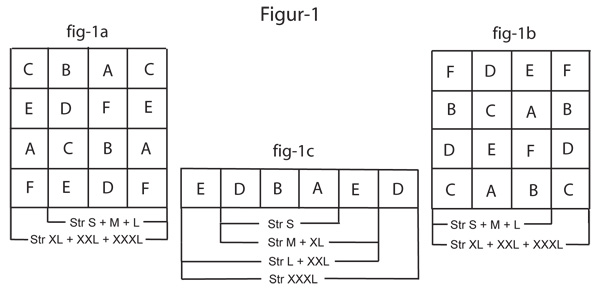 |
|
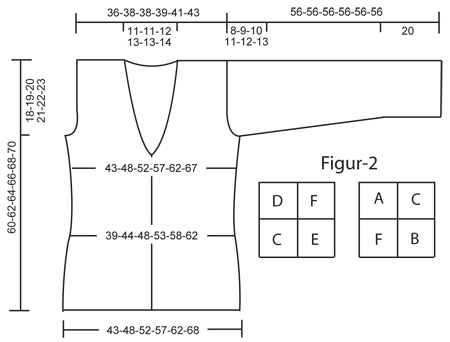 |
|
Have you finished this pattern?Tag your pictures with #dropspattern or submit them to the #dropsfan gallery. Do you need help with this pattern?You'll find 13 tutorial videos, a Comments/Questions area and more by visiting the pattern on garnstudio.com. © 1982-2025 DROPS Design A/S. We reserve all rights. This document, including all its sub-sections, has copyrights. Read more about what you can do with our patterns at the bottom of each pattern on our site. |
|







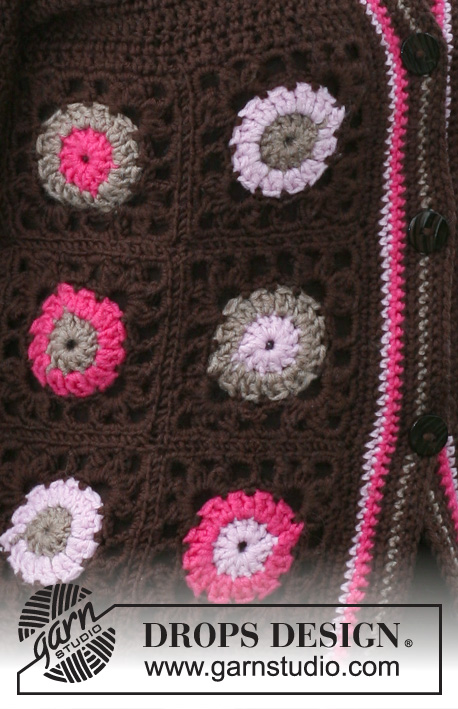






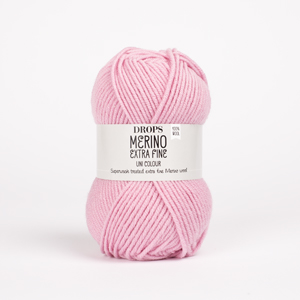
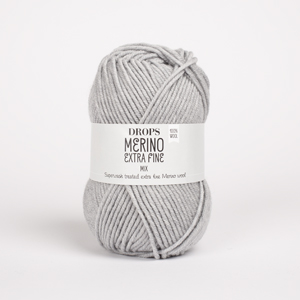




























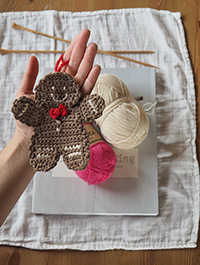
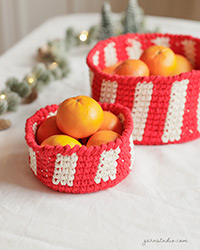
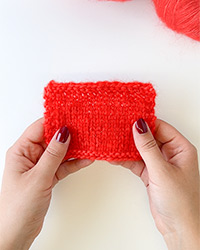
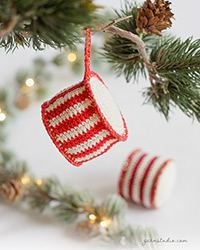
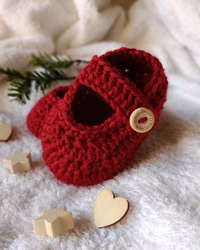
Post a comment to pattern DROPS 115-14
We would love to hear what you have to say about this pattern!
If you want to leave a question, please make sure you select the correct category in the form below, to speed up the answering process. Required fields are marked *.